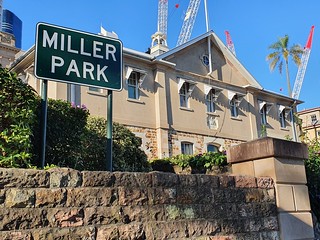Opposite the Commander’s House facing the the river is the ‘new’ Commissariat Store. It replaced the one built in 1825. The new Store was built in 1829 and is the only remaining convict building in this area, situated with the rear end to what is now William Street.
King’s Wharf lay in front of the Store which made double handling for transport unnecessary. The building acted as the procurement and storage depot for all the settlements’ food, seed, tools, timber, clothing and equipment. There was a permanent military guard on duty. Parallel to the wharf was a large shed to store sails , oars , tackle, etc. In order to prevent escapes these parts were stored every night in the shed. For a while in 1929 the shed was also used for the school. Reverend Vincent complained that these kids were to close to were those rough convicts were working.
The only entry point into the penal settlement was via the wharf on the Brisbane River. Initially known as the King’s Wharf, or King’s Jetty (George IV was the king at that time). It stood close to the boat crew’s hut and boat builder’s shed which were constructed in 1827.
A crane was constructed on the end of the wharf in order to transfer goods from the arriving ships to the shore. The cutter the Regent Bird was the first ship that was stationed here for the transport needs of the settlement. It was used by the army, the convict department as well as the Commissariat. For a long time the commander of the vessel was Paddy King, known as the Admiral. He had richly painted the boat in many different colours. Under his command, the state of the ship as well as tackle, sails and rigging were simply the best.
From Kings Wharf it also transported supplies to the stores in Dunwich, the pilot station as Amity Point and upriver to Ipswich. They preferred free men as sailors rather than convicts as they were worried they would use the ship to get away.
In 1828 a second wharf was built, this time from stone, at the end of Edward Street. This was used to transport stones from the quarries across the river at Kangaroo Point to the settlement.
In 1837 after the ascendancy of Queen Victoria the name of the wharf was changed into the current Queen’s Wharf. This after 1842 became the first point of disembarkation of the sponsored immigrants to the free colony. The peak time was from from 1848 to 1897.
Access to the settlement was through a block of vacant land next to the Commissariat Store, which is now Miller Park.

Once the colony was opened for free settlement the store was used by the various government departments. Grain was stored on the top floor and once the colony of Queensland started to grow was also exported from here to other settlements. As the colony grew wharf started to emerge all along the river especially in South Brisbane and along Eagle Street Wharf.